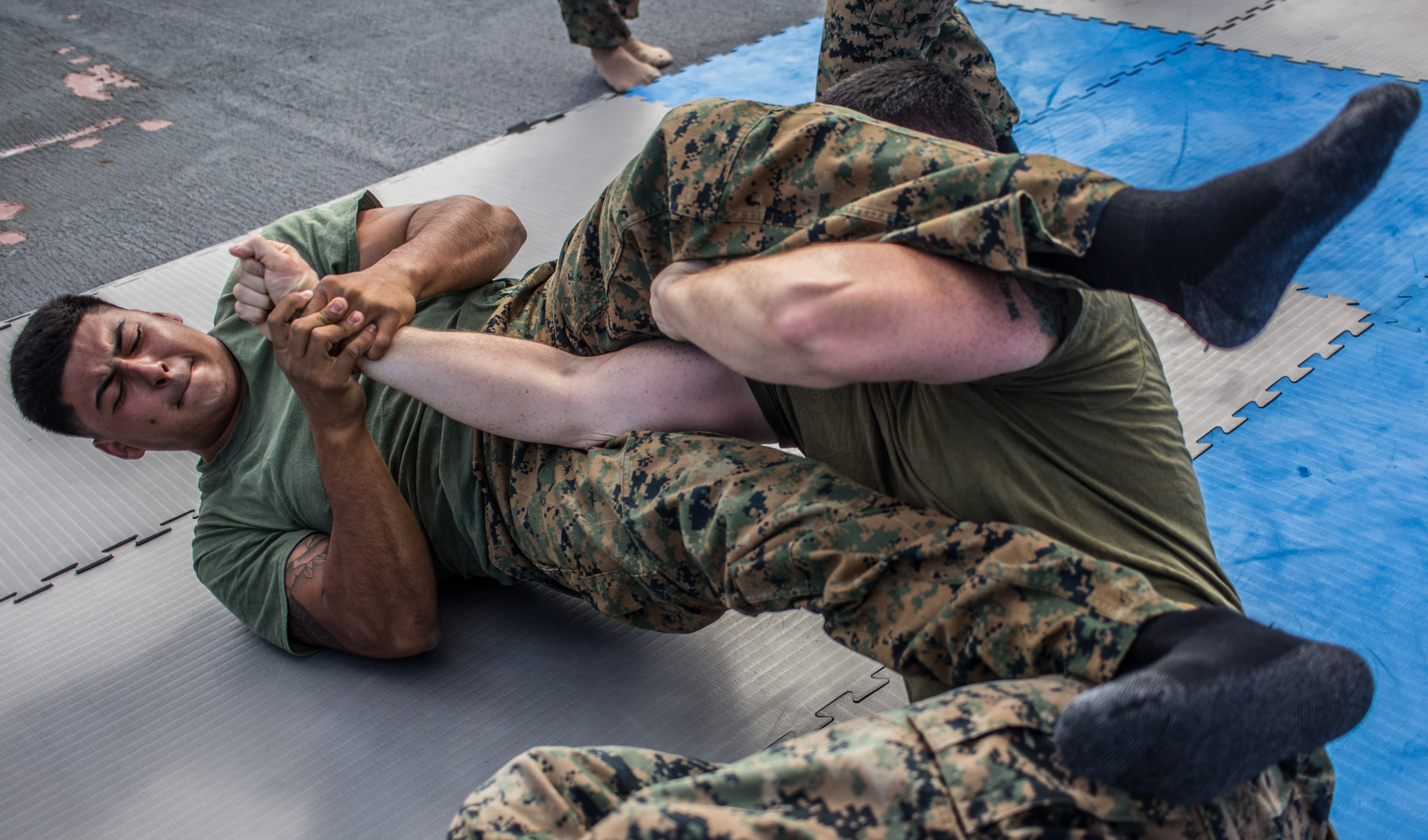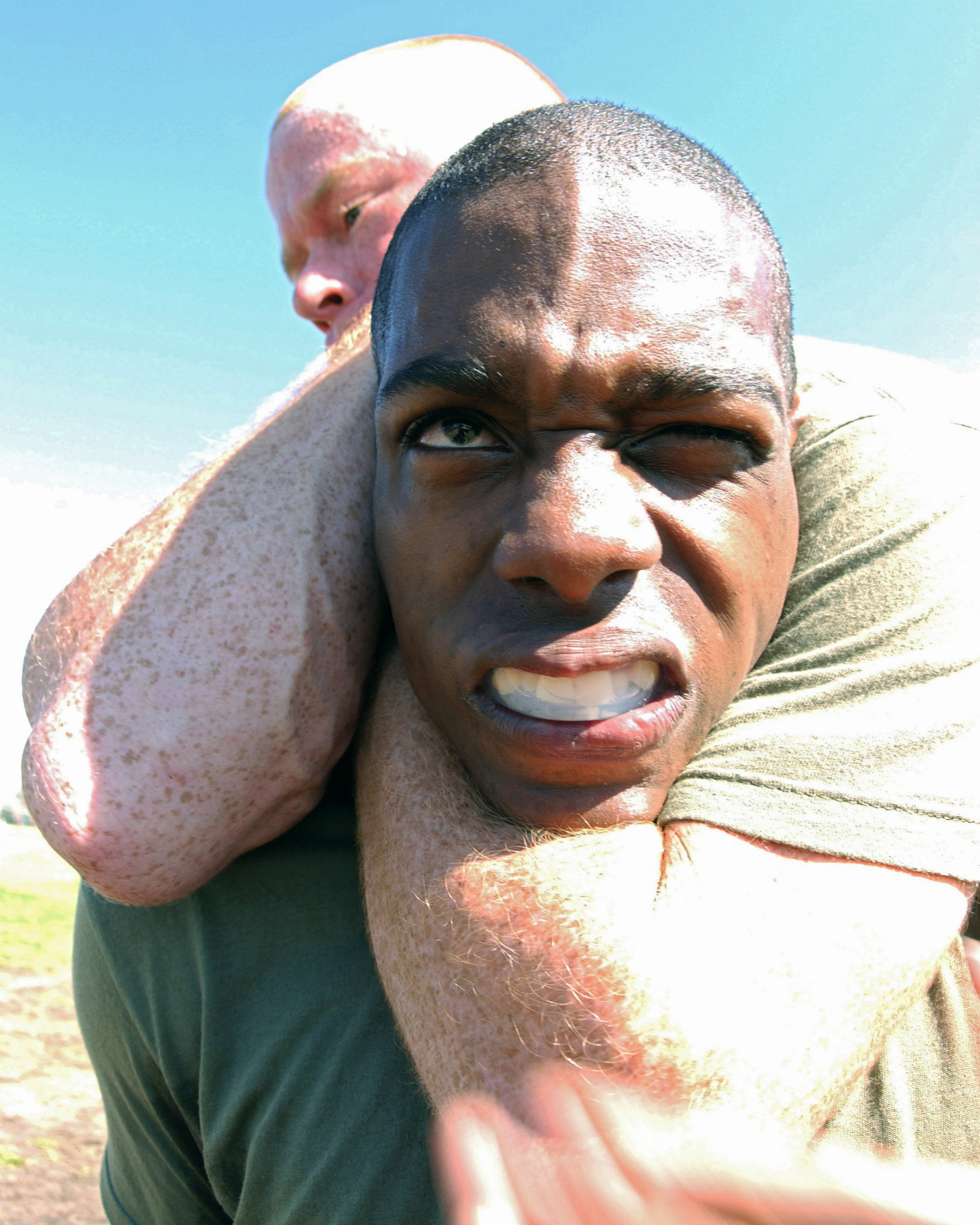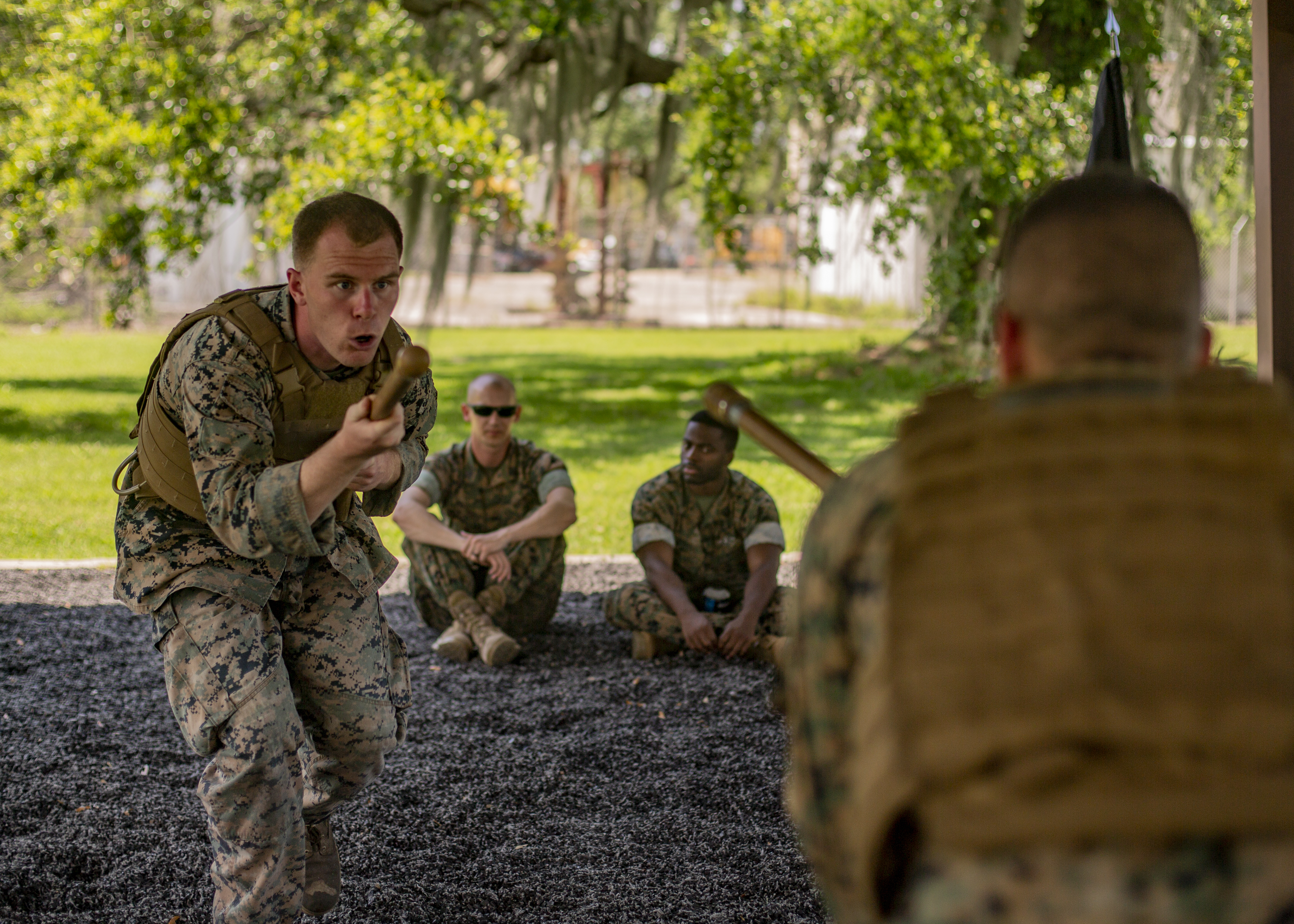|
Chokehold
A chokehold, choke, stranglehold or, in Judo, shime-waza () is a general term for a grappling hold that critically reduces or prevents either air ( choking)''The New Oxford Dictionary of English'' (1999). Oxford University press. . or blood ( strangling) from passing through the neck of an opponent. The restriction may be of one or both and depends on the hold used and the reaction of the victim. While the time it takes for the choke to render an opponent unconscious varies depending on the type of choke, the average across all has been recorded as 9 seconds. The lack of blood or air often leads to unconsciousness or even death if the hold is maintained. Chokeholds are used in martial arts, combat sports, self-defense, law enforcement and in military hand to hand combat applications. They are considered superior to brute-force manual strangling, which generally requires a large disparity in physical strength to be effective.Jones, RichardAsphyxia. ''www.forensicmed.co.uk''. UR ... [...More Info...] [...Related Items...] OR: [Wikipedia] [Google] [Baidu] |
Grappling Hold
A grappling hold, commonly referred to simply as a hold that in Japanese language, Japanese is referred to as ''katame-waza'' ( "grappling technique"), is any specific grappling, wrestling, judo, or other martial art grip that is applied to an opponent. Grappling holds are used principally to control the opponent and to advance in points or grappling position, positioning. The holds may be categorized by their function, such as #Clinch hold, clinching, #Pinning hold, pinning, or #Submission hold, submission, while others can be classified by their anatomical effect: chokehold, headlock, joint-lock, or compression lock. Multiple categories may be appropriate for some of these holds. Clinch hold A clinch hold (also known as a clinching hold) is a grappling hold that is used in clinch fighting with the purpose of controlling the opponent. In wrestling it is referred to as the tie-up. The use of a clinch hold results in the grappling position#Stand-up grappling position, clinch. ... [...More Info...] [...Related Items...] OR: [Wikipedia] [Google] [Baidu] |
Sambo (martial Art)
Sambo is a combat sport, and a recognized style of amateur wrestling governed by the United World Wrestling, UWW in the World Wrestling Championships along with Greco-Roman wrestling and freestyle wrestling. Practiced worldwide, sambo is a martial art with Soviet origins. Many of its moves have been incorporated in other forms of combat sport such as mixed martial arts. Etymology It originated in the Russian Soviet Federative Socialist Republic, Russian SFSR of the Soviet Union during the 1920s. The word ''sambo'' is an acronym of (), which literally translates to 'self-defence without weapons'. Sambo is a martial art and combat sport developed and used by the Soviet Red Army in the early 1920s to improve their hand-to-hand combat abilities. The sport incorporates various styles of wrestling and other self-defence systems such as Kickboxing, kick-boxing and fencing. Soviet martial arts expert Vasili Oshchepkov is credited as one of the founding fathers. Viktor Spiridono ... [...More Info...] [...Related Items...] OR: [Wikipedia] [Google] [Baidu] |
Rear Naked Choke
The rear naked choke (RNC), also known as hadaka jime (裸絞) in Judo and "lion killer choke (Mata Leão)" in BJJ, is a chokehold in martial arts applied from an opponent's back. The word ''naked'' in this context suggests that, unlike other strangulation techniques found in jiujitsu/judo, this hold does not require the use of a keikogi ("gi") or training uniform. The choke has two variations: in one version, the attacker's arm encircles the opponent's neck and then grabs their biceps/shoulder on the other arm (see below for details); in the second version, the attacker clasps their hands together instead after encircling the opponent's neck. Recent studies have shown that the rear-naked choke takes an average of 8.9 seconds to render an opponent unconscious, regardless of the grip that is used. "Figure four" or "short" variation This variant is considered to be a "''Chokehold#Blood choke, blood choke''" because it restricts blood flow to the brain via the carotid artery, caroti ... [...More Info...] [...Related Items...] OR: [Wikipedia] [Google] [Baidu] |
Martial Arts
Martial arts are codified systems and traditions of combat practiced for a number of reasons such as self-defence; military and law enforcement applications; combat sport, competition; physical, mental, and spiritual development; entertainment; and the preservation of a nation's intangible cultural heritage. The concept of martial arts was originally associated with East Asian tradition, but subsequently the term has been applied to practices that originated outside that region. Etymology "Martial arts" is a direct English translation of the Sino-Japanese word (, ). Literally, it refers to "武 martial" and "芸 arts". The term ''martial arts'' was popularized by mainstream popular culture during the 1960s to 1970s, notably by Hong Kong action cinema, Hong Kong martial arts films (most famously those of Bruce Lee) during the so-called "chopsocky" wave of the early 1970s. According to John Clements, the term '':wikt:martial art, martial arts'' itself is derived from an older ... [...More Info...] [...Related Items...] OR: [Wikipedia] [Google] [Baidu] |
Rear Naked Choke
The rear naked choke (RNC), also known as hadaka jime (裸絞) in Judo and "lion killer choke (Mata Leão)" in BJJ, is a chokehold in martial arts applied from an opponent's back. The word ''naked'' in this context suggests that, unlike other strangulation techniques found in jiujitsu/judo, this hold does not require the use of a keikogi ("gi") or training uniform. The choke has two variations: in one version, the attacker's arm encircles the opponent's neck and then grabs their biceps/shoulder on the other arm (see below for details); in the second version, the attacker clasps their hands together instead after encircling the opponent's neck. Recent studies have shown that the rear-naked choke takes an average of 8.9 seconds to render an opponent unconscious, regardless of the grip that is used. "Figure four" or "short" variation This variant is considered to be a "''Chokehold#Blood choke, blood choke''" because it restricts blood flow to the brain via the carotid artery, caroti ... [...More Info...] [...Related Items...] OR: [Wikipedia] [Google] [Baidu] |
Strangling
Strangling or strangulation is compression of the neck that may lead to unconsciousness or death by causing an increasingly hypoxic state in the brain by restricting the flow of oxygen through the trachea. Fatal strangulation typically occurs in cases of violence, accidents, and is one of two main ways that hanging causes death (alongside breaking the victim's neck). Strangling does not have to be fatal; limited or interrupted strangling is practised in erotic asphyxia, in the choking game, and is an important technique in many combat sports and self-defense systems. Strangling can be divided into three general types according to the mechanism used: * Hanging — Suspension from a cord wound around the neck * Ligature strangulation — Strangulation without suspension using some form of cord-like object ( ligature) called a garrote * Manual strangulation — Strangulation using the fingers, hands, or other extremity General Strangling involves one or several mechanism ... [...More Info...] [...Related Items...] OR: [Wikipedia] [Google] [Baidu] |
Martial Art
Martial arts are codified systems and traditions of combat practiced for a number of reasons such as self-defence; military and law enforcement applications; competition; physical, mental, and spiritual development; entertainment; and the preservation of a nation's intangible cultural heritage. The concept of martial arts was originally associated with East Asian tradition, but subsequently the term has been applied to practices that originated outside that region. Etymology "Martial arts" is a direct English translation of the Sino-Japanese word (, ). Literally, it refers to "武 martial" and "芸 arts". The term ''martial arts'' was popularized by mainstream popular culture during the 1960s to 1970s, notably by Hong Kong martial arts films (most famously those of Bruce Lee) during the so-called " chopsocky" wave of the early 1970s. According to John Clements, the term ''martial arts'' itself is derived from an older Latin term meaning "arts of Mars", the Roman god of w ... [...More Info...] [...Related Items...] OR: [Wikipedia] [Google] [Baidu] |
Vertebrate Trachea
The trachea (: tracheae or tracheas), also known as the windpipe, is a cartilaginous tube that connects the larynx to the bronchi of the lungs, allowing the passage of air, and so is present in almost all animals' lungs. The trachea extends from the larynx and branches into the two primary bronchi. At the top of the trachea, the cricoid cartilage attaches it to the larynx. The trachea is formed by a number of horseshoe-shaped rings, joined together vertically by overlying ligaments, and by the trachealis muscle at their ends. The epiglottis closes the opening to the larynx during swallowing. The trachea begins to form in the second month of embryo development, becoming longer and more fixed in its position over time. Its epithelium is lined with column-shaped cells that have hair-like extensions called cilia, with scattered goblet cells that produce protective mucins. The trachea can be affected by inflammation or infection, usually as a result of a viral illness affectin ... [...More Info...] [...Related Items...] OR: [Wikipedia] [Google] [Baidu] |
Larynx
The larynx (), commonly called the voice box, is an organ (anatomy), organ in the top of the neck involved in breathing, producing sound and protecting the trachea against food aspiration. The opening of larynx into pharynx known as the laryngeal inlet is about 4–5 centimeters in diameter. The larynx houses the vocal cords, and manipulates pitch (music), pitch and sound pressure, volume, which is essential for phonation. It is situated just below where the tract of the pharynx splits into the trachea and the esophagus. The word 'larynx' (: larynges) comes from the Ancient Greek word ''lárunx'' ʻlarynx, gullet, throatʼ. Structure The triangle-shaped larynx consists largely of cartilages that are attached to one another, and to surrounding structures, by muscles or by fibrous and elastic tissue components. The larynx is lined by a respiratory epithelium, ciliated columnar epithelium except for the vocal folds. The laryngeal cavity, cavity of the larynx extends from its tria ... [...More Info...] [...Related Items...] OR: [Wikipedia] [Google] [Baidu] |
Laryngopharynx
The pharynx (: pharynges) is the part of the throat behind the mouth and nasal cavity, and above the esophagus and trachea (the tubes going down to the stomach and the lungs respectively). It is found in vertebrates and invertebrates, though its structure varies across species. The pharynx carries food to the esophagus and air to the larynx. The flap of cartilage called the epiglottis stops food from entering the larynx. In humans, the pharynx is part of the digestive system and the conducting zone of the respiratory system. (The conducting zone—which also includes the nostrils of the nose, the larynx, trachea, bronchi, and bronchioles—filters, warms, and moistens air and conducts it into the lungs). The human pharynx is conventionally divided into three sections: the nasopharynx, oropharynx, and laryngopharynx (hypopharynx). In humans, two sets of pharyngeal muscles form the pharynx and determine the shape of its lumen. They are arranged as an inner layer of longitudinal mu ... [...More Info...] [...Related Items...] OR: [Wikipedia] [Google] [Baidu] |
Hyoid Bone
The hyoid-bone (lingual-bone or tongue-bone) () is a horseshoe-shaped bone situated in the anterior midline of the neck between the chin and the thyroid-cartilage. At rest, it lies between the base of the mandible and the third cervical vertebra. Unlike other bones, the hyoid is only distantly articulated to other bones by muscles or ligaments. It is the only bone in the human body that is not connected to any other bones. The hyoid is anchored by muscles from the anterior, posterior and inferior directions, and aids in tongue movement and swallowing. The hyoid bone provides attachment to the muscles of the floor of the mouth and the tongue above, the larynx below, and the epiglottis and pharynx behind. Its name is derived . Structure The hyoid bone is classed as an irregular bone and consists of a central part called the body, and two pairs of horns, the greater and lesser horns. Body The body of the hyoid bone is the central part of the hyoid bone. *At the fron ... [...More Info...] [...Related Items...] OR: [Wikipedia] [Google] [Baidu] |
Asphyxia
Asphyxia or asphyxiation is a condition of deficient supply of oxygen to the body which arises from abnormal breathing. Asphyxia causes generalized hypoxia, which affects all the tissues and organs, some more rapidly than others. There are many circumstances that can induce asphyxia, all of which are characterized by the inability of a person to acquire sufficient oxygen through breathing for an extended period of time. Asphyxia can cause coma or death. In 2015, about 9.8 million cases of unintentional suffocation occurred which resulted in 35,600 deaths. The word asphyxia is from Ancient Greek "without" and , "squeeze" (throb of heart). Causes Situations that can cause asphyxia include but are not limited to: airway obstruction (such as from asthma, laryngospasm, or simple blockage from the presence of foreign materials); from being in environments where oxygen is not readily accessible: such as underwater, in a low oxygen atmosphere, or in a vacuum; environments where s ... [...More Info...] [...Related Items...] OR: [Wikipedia] [Google] [Baidu] |






